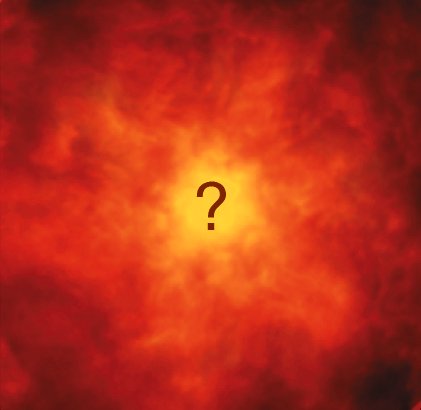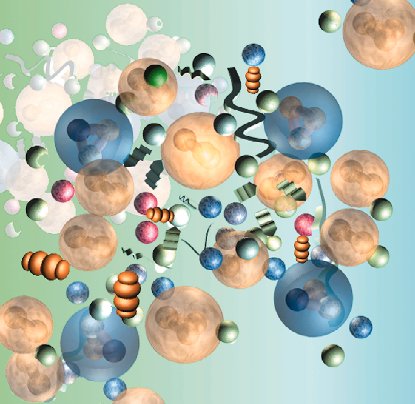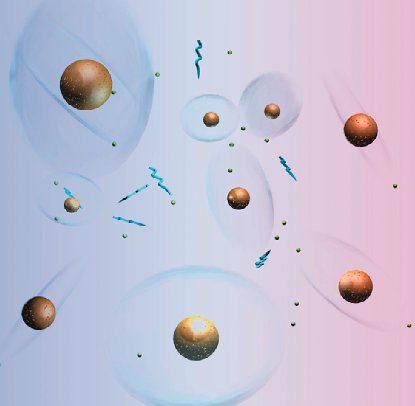Back to Creation
Physicists believe that the Universe was born about 15 thousand million years
ago in a hot Big Bang and that it has been slowly cooling ever since. As the
Universe expands its energy density drops, and so today the temperature of
outer space has fallen to a chilly 3 degrees above absolute zero. If we can create
high energy densities in particle collisions at laboratories like CERN, it is
equivalent to taking a trip back in time, allowing us to see how the Universe
behaved closer to the Big Bang.
All we know about the Big Bang is that all the matter in the Universe must have
been condensed into a very tiny space. We don't know what made the Big Bang
happen, or what went on in that first instant. When scientists talk about the Big
Bang they are usually referring to the explosive expansion that followed. This
was no ordinary explosion, it didn't just happen in space and time, it actually
created them.
By looking far out into today's Universe and peering deeply into the world of
fundamental particles, scientists have pieced together the evolution of the
Universe from the inconceivably short time of just 10-43 seconds
(that's a decimal point followed by 42 zeros and then a 1) after it all began.
At that point in time, things were happening very fast. All of nature's interactions
were indistinguishable and particles of matter and antimatter existed in equal
amounts. Matter and antimatter were constantly annihilating to produce
radiation and being recreated from that radiation. Matter was compressed so
densely that even light could not travel far and the Universe was opaque.
During the next phase of the Universe's existence, up to around 10-34
seconds, the strong interaction that acts on quarks became distinct from the electromagnetic
and weak interactions, which remained indistinguishable. Protons and neutrons
couldn't yet form because any ties between quarks were rapidly broken by the
high energy radiation that still pervaded the Universe. Matter was a sort of high
density cosmic soup called Quark Gluon Plasma, QGP.
The carriers of the weak interaction, W and Z particles, were as abundant as
photons, the carriers of the electromagnetic interaction, and they behaved in the
same way. At around this time, a tiny excess of matter over antimatter began to
develop, just one matter particle surviving for every thousand million particles to
annihilate with antimatter. It is these few survivors that make up our Universe
today. What remains of the rest is a background radiation that gives the Universe
a temperature of 3 Kelvin in between stars and galaxies.
Between 10-34 seconds and 10-10 seconds the electromagnetic
and weak interactions stopped acting together. There was no longer enough energy
density to produce free W and Z particles and those that had already been made
decayed away. From now on W and Z particles would only occur as carriers of the weak
interaction.
Antimatter started to disappear because when quarks annihilated with
antiquarks there was no longer enough energy in the radiation to recreate them.
Particle physics experiments have already begun to probe back in time as far as
this by crashing particles together with enough energy to recreate the conditions
of the early Universe at laboratories like CERN.
Soon after, the energy of the radiation had fallen sufficiently to allow protons
and neutrons to form as well as short-lived particles, called mesons, made of a
quark and an antiquark. Heavier quarks became fewer and fewer as the Universe
cooled and there was no longer enough energy to make them. Those that existed
decayed away into lighter quarks.
Up to about a second, proton and neutron building continued. The remaining
antimatter, in the form of positrons, disappeared as the radiation energy density
dropped below that necessary to create electron-positron pairs. With no
antimatter left in the Universe other than a few particles locked up inside
mesons, what is left is the one in a thousand million matter particles resulting
from nature's apparent preference for matter.
After that, things really slowed down. Up to around three minutes, protons and
neutrons started to combine to produce light atomic nuclei. The Universe was
like a giant thermonuclear reactor until, at around three minutes, the reactions
stopped leaving a Universe composed of hydrogen, deuterium, helium, and a
little lithium. Even today, the Universe is made up of about 75% hydrogen and
25% helium, with just traces of heavier elements cooked up in stars to make
everything else that we consider to be 'ordinary' matter.
During the next 300 000 years the Universe slowly became transparent as
photons no longer interacted as soon as they were made. Electrons were
captured by the hydrogen, deuterium, helium and lithium nuclei to form the first
atoms.
The first galaxies took a 1000 million years to make as matter began to clump
together in a way that is still not clearly understood. Gravity pulled the light
elements together to form stars which ignited, cooking up elements as heavy as
iron. Some stars, at the end of their lives, exploded in spectacular supernovae,
rapidly generating even heavier elements like gold and scattering them around
the Universe. Slowly, these elements began to clump together into planets.
Molecules formed and chemical processes began.
Finally, after 15 000 million years intelligent beings like you emerged from the
stardust on one of these planets and began to contemplate the Universe around
them, trying to piece together the story that led to us being here.
Particle Physics Education CD-ROM ©2001 CERN







